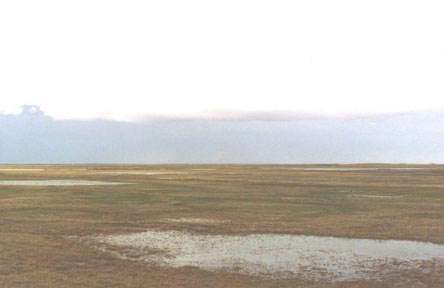
Tundra ponds near Prudhoe Bay, Alaska (c) 2005 Natasha Sherman
Bioimages home (click on an image to enlarge)
view
this page in its intended navigation context
Arctic coastal tundra (WWF
ecoregion NA1103)

Tundra ponds near Prudhoe Bay, Alaska
(c) 2005 Natasha Sherman

Source of bioregions data:
Olson, D. M. and
E. Dinerstein. The Global 200: Priority ecoregions for global conservation. (PDF
file) Annals of the Missouri Botanical Garden 89:125-126.
Distinctiveness (1=highest,4=lowest): 1
(globally outstanding)
This ecoregion supports a wide variety of wildlife and is an important breeding
and calving ground for many species. In particular, major caribou herds
migrate here to calve and many species of birds breed here.*
Conservation Status (1=most endangered, 5=most
intact): 4 (relatively stable)
Over 90% of habitat remains intact. The main threat is associated with oil
development at Prudhoe Bay and possible future development in the coastal plain
of the Arctic National Wildlife Refuge. Roads and pipelines may disrupt
migration patterns.*
Some views from the ecoregion

Aerial photo of tundra, north slope, Alaska (c) 2005
Natasha Sherman
hires


tussocks (left) and vegetation (right), north slope, Alaska
(c) 2005 Natasha Sherman
hires
hires


elevated petroleum pipelines may disrupt migration of large mammals (left), oil
development results in permanent destruction of habitat (right) Kuparick, Alaska
(c) 2005 Natasha Sherman
hires
hires
* Ricketts, T.H., E. Dinerstein, D.M. Olson, C.J. Loucks, et al. (1999) Terrestrial Ecoregions of North America: A Conservation Assessment. World Wildlife Fund - United States and Canada. Island Press, Washington, D.C. pp. 337-340.